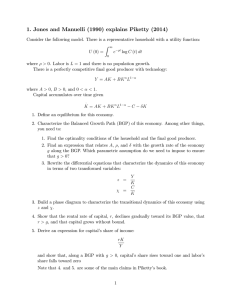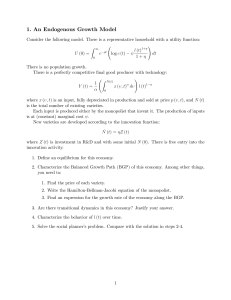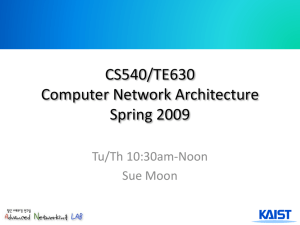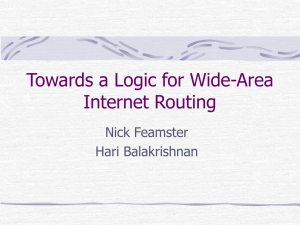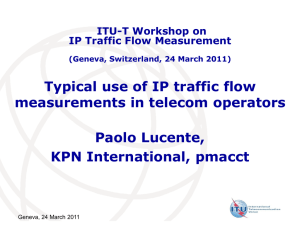Policy-Based Path Vector Routing
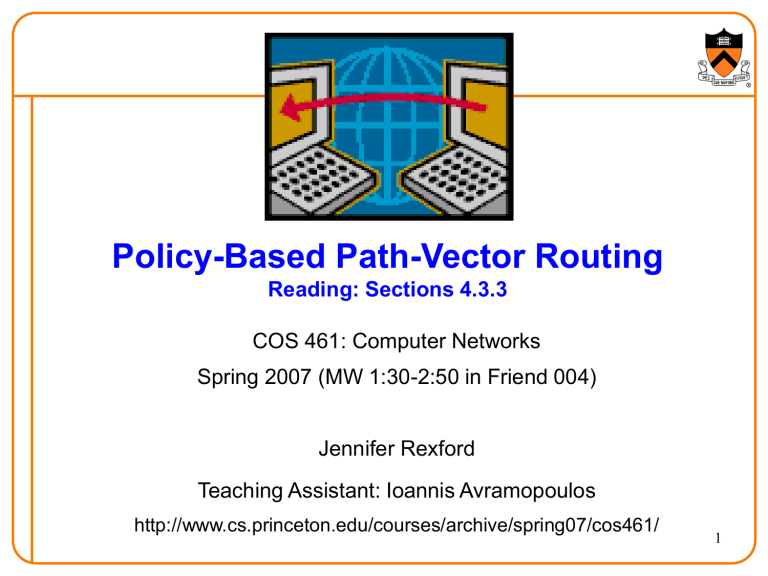
Policy-Based Path-Vector Routing
Reading: Sections 4.3.3
COS 461: Computer Networks
Spring 2007 (MW 1:30-2:50 in Friend 004)
Jennifer Rexford
Teaching Assistant: Ioannis Avramopoulos http://www.cs.princeton.edu/courses/archive/spring07/cos461/
1
Goals of Today’s Lecture
• Challenges of interdomain routing
– Scale, privacy, and policy
– Limitations of link-state and distance-vector routing
• Path-vector routing
– Faster loop detection than distance-vector routing
– More flexibility than shortest-path routing
• Border Gateway Protocol (BGP)
– Incremental, prefix-based, path-vector protocol
– Programmable import and export policies
– Multistep decision process for selecting “best” route
• Multiple routers within an AS
• BGP convergence delay
2
Interdomain Routing
• AS-level topology
– Destinations are IP prefixes (e.g., 12.0.0.0/8)
– Nodes are Autonomous Systems (ASes)
– Edges are links and business relationships
4
3
2
1
Client
7
5
6
Web server
3
Challenges for Interdomain Routing
• Scale
– Prefixes: 150,000-200,000, and growing
– ASes: 20,000+ visible ones, and growing
– AS paths and routers: at least in the millions…
• Privacy
– ASes don’t want to divulge internal topologies
– … or their business relationships with neighbors
• Policy
– No Internet-wide notion of a link cost metric
– Need control over where you send traffic
– … and who can send traffic through you
4
Shortest-Path Routing is Restrictive
• All traffic must travel on shortest paths
• All nodes need common notion of link costs
• Incompatible with commercial relationships
Regional
ISP3
National
ISP1
Regional
ISP2
National
ISP2
YES
NO
Regional
ISP1
Cust3 Cust1
Cust2
5
Link-State Routing is Problematic
• Topology information is flooded
– High bandwidth and storage overhead
– Forces nodes to divulge sensitive information
• Entire path computed locally per node
– High processing overhead in a large network
• Minimizes some notion of total distance
– Works only if policy is shared and uniform
• Typically used only inside an AS
– E.g., OSPF and IS-IS
6
Distance Vector is on the Right Track
• Advantages
– Hides details of the network topology
– Nodes determine only “next hop” toward the dest
• Disadvantages
– Minimizes some notion of total distance, which is difficult in an interdomain setting
– Slow convergence due to the counting-to-infinity problem (“bad news travels slowly”)
• Idea: extend the notion of a distance vector
– To make it easier to detect loops
7
Path-Vector Routing
• Extension of distance-vector routing
– Support flexible routing policies
– Avoid count-to-infinity problem
• Key idea: advertise the entire path
– Distance vector: send distance metric per dest d
– Path vector: send the entire path for each dest d
3
“d: path (2,1)” data traffic
2
“d: path (1)” data traffic
1 d
8
Faster Loop Detection
• Node can easily detect a loop
– Look for its own node identifier in the path
– E.g., node 1 sees itself in the path “3, 2, 1”
• Node can simply discard paths with loops
– E.g., node 1 simply discards the advertisement
3
“d: path (2,1)”
2
“d: path (3,2,1)”
“d: path (1)”
1
9
Flexible Policies
• Each node can apply local policies
– Path selection: Which path to use?
– Path export: Which paths to advertise?
• Examples
– Node 2 may prefer the path “2, 3, 1” over “2, 1”
– Node 1 may not let node 3 hear the path “1, 2”
2
3 2
3
1 1
10
Border Gateway Protocol
• Interdomain routing protocol for the Internet
– Prefix-based path-vector protocol
– Policy-based routing based on AS Paths
– Evolved during the past 17 years
• 1989 : BGP-1 [RFC 1105], replacement for EGP
• 1990 : BGP-2 [RFC 1163]
• 1991 : BGP-3 [RFC 1267]
• 1995 : BGP-4 [RFC 1771], support for CIDR
• 2006 : BGP-4 [RFC 4271], update
11
BGP Operations
Establish session on
TCP port 179
AS1
BGP session
Exchange all active routes
Exchange incremental updates
AS2
While connection is ALIVE exchange route UPDATE messages
12
Incremental Protocol
• A node learns multiple paths to destination
– Stores all of the routes in a routing table
– Applies policy to select a single active route
– … and may advertise the route to its neighbors
• Incremental updates
– Announcement
Upon selecting a new active route, add node id to path
… and (optionally) advertise to each neighbor
– Withdrawal
If the active route is no longer available
… send a withdrawal message to the neighbors
13
BGP Route
• Destination prefix (e.g,. 128.112.0.0/16)
• Route attributes, including
– AS path (e.g., “7018 88”)
– Next-hop IP address (e.g., 12.127.0.121)
12.127.0.121
192.0.2.1
AS 7018
AT&T
AS 88
Princeton
AS 12654
RIPE NCC
RIS project
128.112.0.0/16
AS path = 88
Next Hop = 192.0.2.1
128.112.0.0/16
AS path = 7018 88
Next Hop = 12.127.0.121
14
ASPATH Attribute
128.112.0.0/16
AS Path = 1755 1239 7018 88
128.112.0.0/16
AS Path = 1239 7018 88
AS 1239
Sprint
128.112.0.0/16
AS Path = 88
AS 88
Princeton
128.112.0.0/16
Prefix Originated
AS 1129
Global Access
AS 1755
Ebone
128.112.0.0/16
AS Path = 1129 1755 1239 7018 88
128.112.0.0/16
AS Path = 7018 88
AS 12654
RIPE NCC
RIS project
AS7018
AT&T
128.112.0.0/16
AS Path = 7018 88
128.112.0.0/16
AS Path = 3549 7018 88
AS 3549
Global Crossing
15
BGP Path Selection
• Simplest case
– Shortest AS path
– Arbitrary tie break
AS 1129
Global Access
• Example
128.112.0.0/16
AS Path = 1129 1755 1239 7018 88
– Three-hop AS path preferred over a five-hop AS path
– AS 12654 prefers path
AS 12654
RIPE NCC
RIS project through Global Crossing
128.112.0.0/16
AS Path = 3549 7018 88 • But, BGP is not limited to shortest-path routing
– Policy-based routing
AS 3549
Global Crossing
16
BGP Policy: Applying Policy to Routes
• Import policy
– Filter unwanted routes from neighbor
E.g. prefix that your customer doesn’t own
– Manipulate attributes to influence path selection
E.g., assign local preference to favored routes
• Export policy
– Filter routes you don’t want to tell your neighbor
E.g., don’t tell a peer a route learned from other peer
– Manipulate attributes to control what they see
E.g., make a path look artificially longer than it is
17
BGP Policy: Influencing Decisions
Receive
BGP
Updates
Open ended programming.
Constrained only by vendor configuration language
Apply Policy = filter routes & tweak attributes
Based on
Attribute
Values
Best
Routes
Apply Policy = filter routes & tweak attributes
Transmit
BGP
Updates
Apply Import
Policies
Best Route
Selection
Best Route
Table
Apply Export
Policies
Install forwarding
Entries for best
Routes.
IP Forwarding Table
18
Import Policy: Local Preference
• Favor one path over another
– Override the influence of AS path length
– Apply local policies to prefer a path
• Example: prefer customer over peer
Local-pref = 90
Sprint
AT&T
Local-pref = 100
Tier-2
Tier-3 Yale
19
Import Policy: Filtering
• Discard some route announcements
– Detect configuration mistakes and attacks
• Examples on session to a customer
– Discard route if prefix not owned by the customer
– Discard route that contains other large ISP in AS path
AT&T USLEC
Princeton
128.112.0.0/16 20
Export Policy: Filtering
• Discard some route announcements
– Limit propagation of routing information
• Examples
– Don’t announce routes from one peer to another
– Don’t announce routes for network-management hosts
UUNET AT&T
Princeton
128.112.0.0/16
Sprint network operator
21
Export Policy: Attribute Manipulation
• Modify attributes of the active route
– To influence the way other ASes behave
• Example: AS prepending
– Artificially inflate the AS path length seen by others
– To convince some ASes to send traffic another way
AT&T Sprint USLEC
88 88 Princeton
128.112.0.0/16
88
22
BGP Policy Configuration
• Routing policy languages are vendor-specific
– Not part of the BGP protocol specification
– Different languages for Cisco, Juniper, etc.
• Still, all languages have some key features
– Policy as a list of clauses
– Each clause matches on route attributes
– … and either discards or modifies the matching routes
• Configuration done by human operators
– Implementing the policies of their AS
– Business relationships, traffic engineering, security, …
– http://www.cs.princeton.edu/~jrex/papers/policies.pdf
23
AS is Not a Single Node
• AS path length can be misleading
– An AS may have many router-level hops
BGP says that path 4 1 is better than path 3 2 1
AS 3
AS 2
AS 4
AS 1
24
An AS is Not a Single Node
• Multiple routers in an AS
– Need to distribute BGP information within the AS
– Internal BGP (iBGP) sessions between routers
AS1 eBGP iBGP
AS2
25
Internal BGP and Local Preference
• Example
– Both routers prefer the path through AS 100 on the left
– … even though the right router learns an external path
AS 200
AS 100 AS 300
Local Pref = 100
I-BGP
Local Pref = 90
AS 256
26
An AS is Not a Single Node
• Multiple connections to neighboring ASes
– Multiple border routers may learn good routes
– … with the same local-pref and AS path length
Multiple links
4
3
5
2
7 6
1
27
Hot-Potato (Early-Exit) Routing
• Hot-potato routing
– Each router selects the closest egress point
– … based on the path cost in intradomain protocol
• BGP decision process
– Highest local preference
– Shortest AS path
– Closest egress point
– Arbitrary tie break
4
F
3
5 dst
C
9
D
8
3
E
8
10 hot potato
4
G
28
Joining BGP and IGP Information
• Border Gateway Protocol (BGP)
– Announces reachability to external destinations
– Maps a destination prefix to an egress point
128.112.0.0/16 reached via 192.0.2.1
• Interior Gateway Protocol (IGP)
– Used to compute paths within the AS
– Maps an egress point to an outgoing link
192.0.2.1 reached via 10.1.1.1
10.1.1.1
192.0.2.1
29
Joining BGP with IGP Information
128.112.0.0/16
Next Hop = 192.0.2.1
128.112.0.0/16
10.10.10.10
IGP destination next hop
192.0.2.0/30 10.10.10.10
+
BGP destination next hop
128.112.0.0/16 192.0.2.1
AS 7018
192.0.2.1
Forwarding Table destination next hop
128.112.0.0/16
192.0.2.0/30
10.10.10.10
10.10.10.10
AS 88
30
Some Routers Don’t Need BGP
• Customer that connects to a single upstream ISP
– The ISP can introduce the prefixes into BGP
– … and the customer can simply default-route to the ISP
Qwest
Nail up routes 130.132.0.0/16 pointing to Yale
Nail up default routes 0.0.0.0/0 pointing to Qwest
Yale University
130.132.0.0/16
31
Some Routers Don’t Need BGP
• Routers inside a “stub” network
– Border router may speak BGP to upstream ISPs
– But, internal routers can simply “default route”
AT&T USLEC
BGP
AS 88
Princeton University
128.112.0.0/16
32
Causes of BGP Routing Changes
• Topology changes
– Equipment going up or down
– Deployment of new routers or sessions
• BGP session failures
– Due to equipment failures, maintenance, etc.
– Or, due to congestion on the physical path
• Changes in routing policy
– Reconfiguration of preferences
– Reconfiguration of route filters
• Persistent protocol oscillation
– Conflicts between policies in different ASes
33
BGP Session Failure
• BGP runs over TCP
– BGP only sends updates when changes occur
– TCP doesn’t detect lost connectivity on its own
• Detecting a failure
– Keep-alive: 60 seconds
– Hold timer: 180 seconds
• Reacting to a failure
– Discard all routes learned from the neighbor
– Send new updates for any routes that change
AS1
AS2
34
Routing Change: Before and After
0
(1,0)
1
(2,0)
2
0
(2,0)
1
(1,2,0)
2
(3,1,0) (3,2,0)
3 3
35
Routing Change: Path Exploration
• AS 1
– Delete the route (1,0)
– Switch to next route (1,2,0)
– Send route (1,2,0) to AS 3
• AS 3
– Sees (1,2,0) replace (1,0)
– Compares to route (2,0)
– Switches to using AS 2
1
0
(1,2,0)
(2,0)
2
(3,2,0)
3
36
Routing Change: Path Exploration
• Initial situation
– Destination 0 is alive
– All ASes use direct path
• When destination dies
– All ASes lose direct path
– All switch to longer paths
– Eventually withdrawn
• E.g., AS 2
– (2,0) (2,1,0)
– (2,1,0) (2,3,0)
– (2,3,0) (2,1,3,0)
– (2,1,3,0) null
(1,0)
(1,2,0)
(1,3,0)
1
0
3
(2,0)
(2,1,0)
(2,3,0)
(2,1,3,0)
2
(3,0)
(3,1,0)
BGP Converges Slowly, if at All
• Path vector avoids count-to-infinity
– But, ASes still must explore many alternate paths
– … to find the highest-ranked path that is still available
• Fortunately, in practice
– Most popular destinations have very stable BGP routes
– And most instability lies in a few unpopular destinations
• Still, lower BGP convergence delay is a goal
– Can be tens of seconds to tens of minutes
– High for important interactive applications
– … or even conventional application, like Web browsing
38
Conclusions
• BGP is solving a hard problem
– Routing protocol operating at a global scale
– With tens of thousands of independent networks
– That each have their own policy goals
– And all want fast convergence
• Key features of BGP
– Prefix-based path-vector protocol
– Incremental updates (announcements and withdrawals)
– Policies applied at import and export of routes
– Internal BGP to distribute information within an AS
– Interaction with the IGP to compute forwarding tables
39

